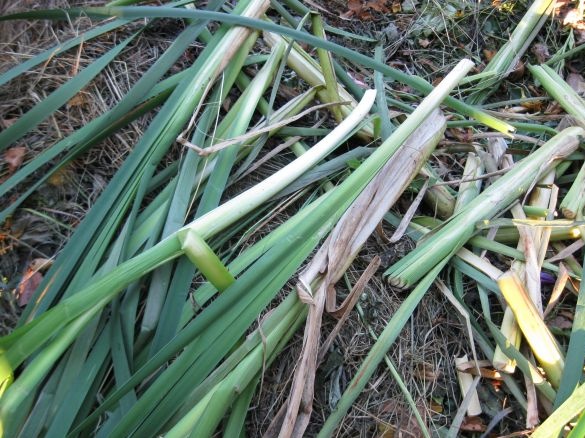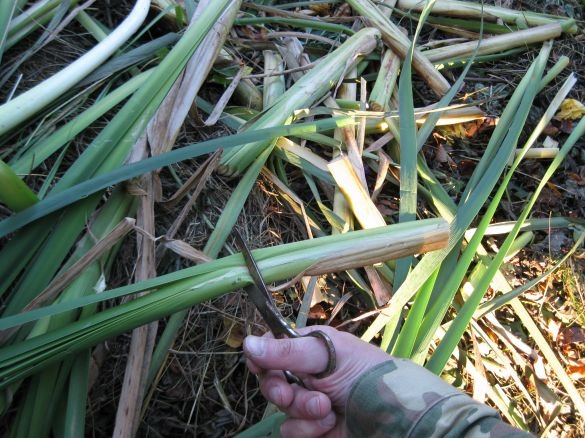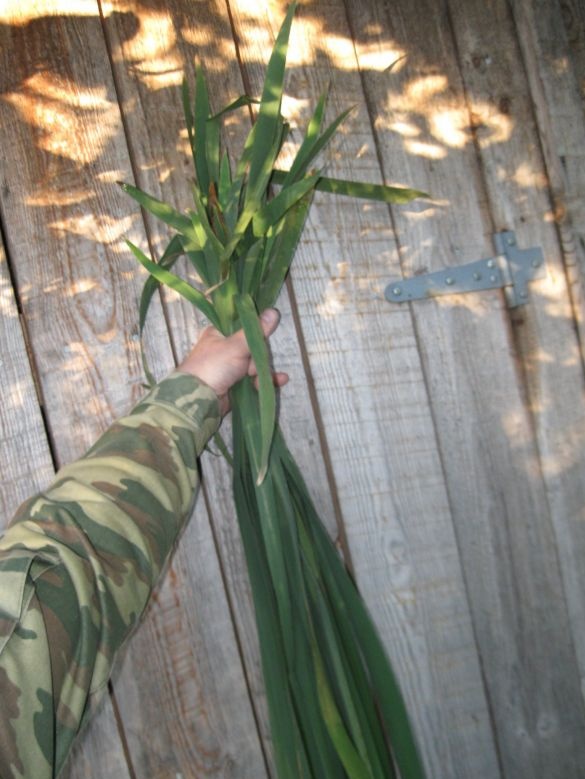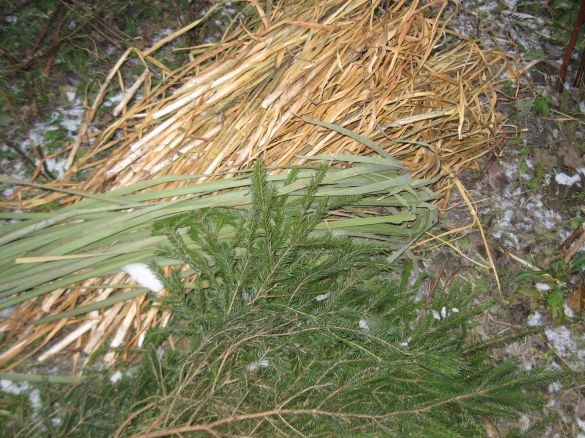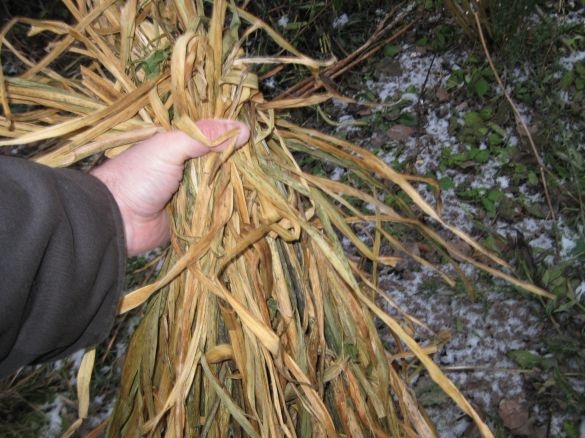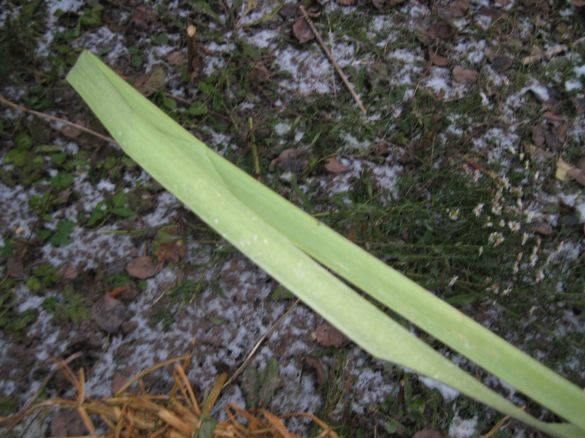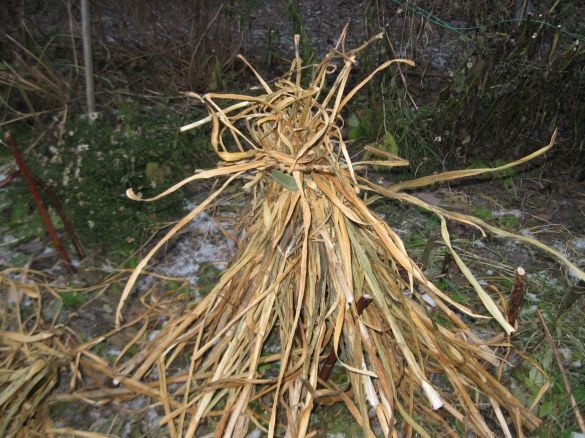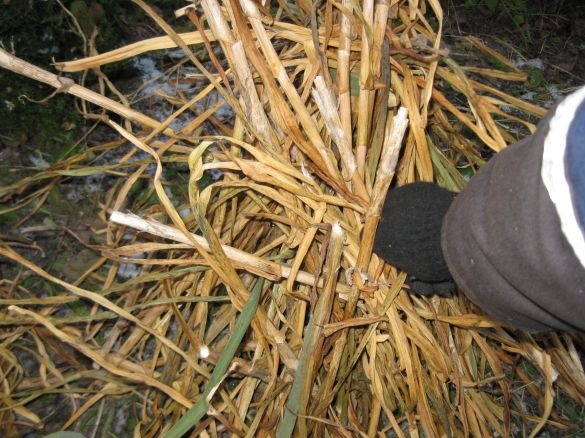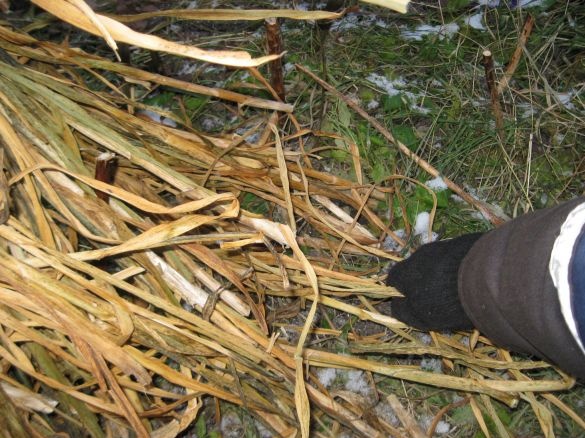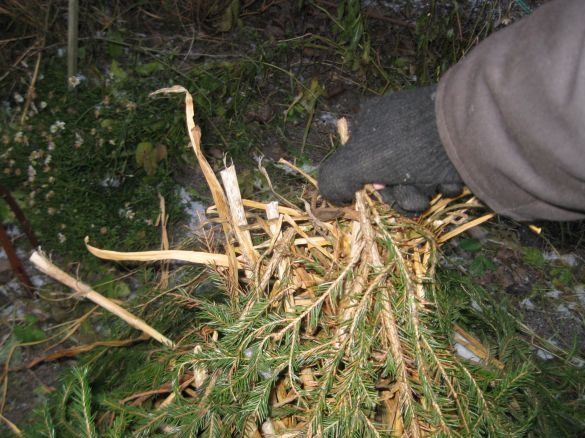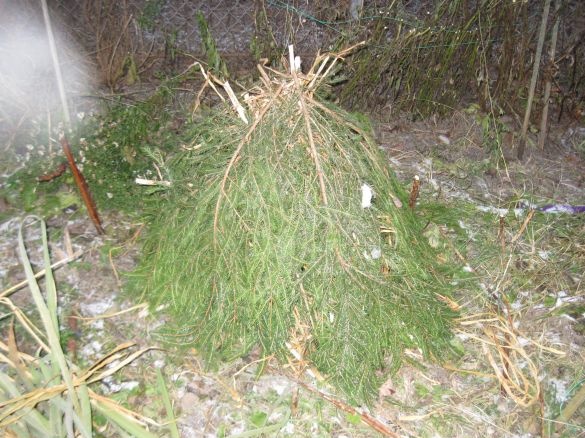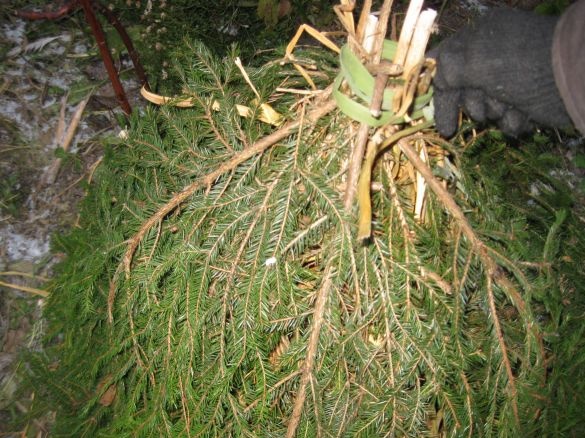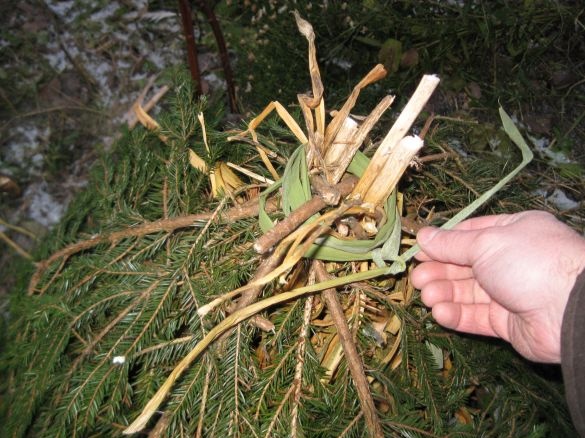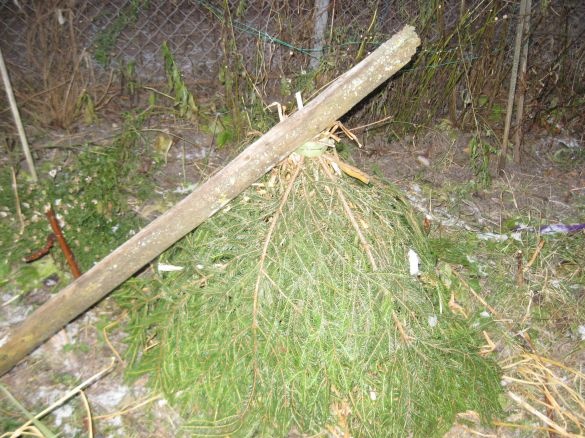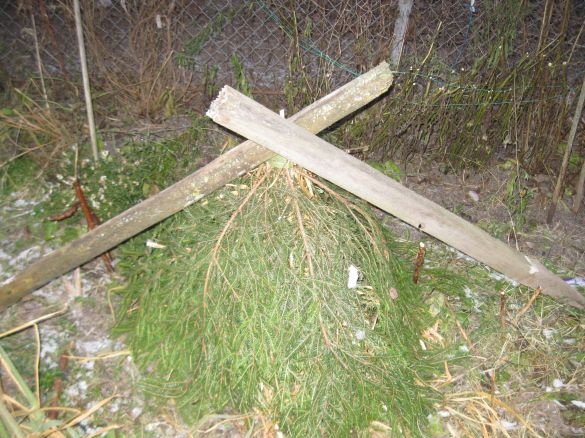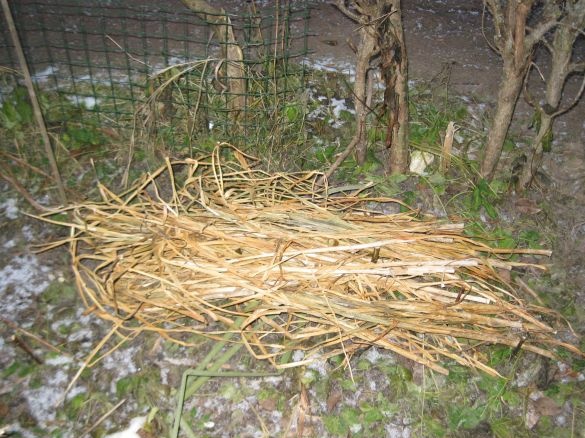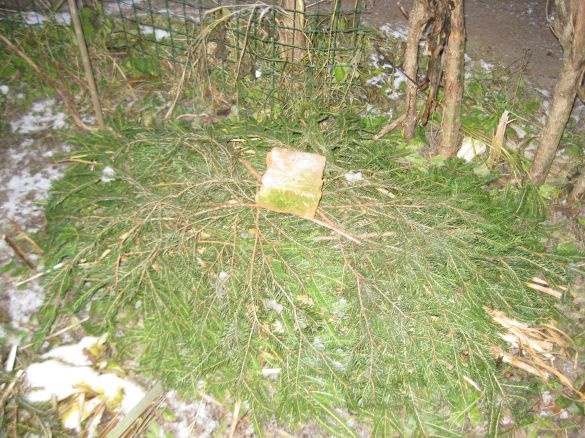One of the options for winter shelter for thermophilic garden plants. The materials used for this - dry stalks of garlic, as well as spruce spruce branches, are natural, environmentally friendly materials, and in addition, they effectively protect plants from frost and from rodents.
As you know, many garden plants need shelter for the winter. However, there are many different materials for sheltering such plants. These are natural materials (fir spruce branches, fallen leaves, straw, hay, etc.), as well as artificial materials, for example, various films and covers made of non-woven material (spunbond, lutrasil, etc.).
In my opinion, the best option for sheltering plants is the use of natural, natural materials. Of course, not all summer residents or gardeners have the opportunity to easily get them, however, if such an opportunity exists, it is best to use these materials for shelter.
Natural materials have many advantages. This is ecological cleanliness, and the zero cost of such materials, which is especially important if you have to cover a lot of plants and when buying artificial material in a store, this can lead to significant financial costs. In addition, natural covering materials have another important advantage. In the spring they will not need to be washed and cleaned, and then they will also have to look for a place for cleaning and storage, but you can simply send them to compost and then, after they decay and turn into humus, get additional natural, high-quality and at the same time absolutely free fertilizer . Or another option, just burn these materials on a fire and then collect the ash, which is also a very good natural fertilizer.
Perhaps the best natural material for sheltering plants is spruce spruce branches. As a covering material, it has two very significant advantages. First of all, spruce branches pass air well, which promotes natural ventilation and protects the sheltered plant from aging. Secondly, spruce branches hold snow very well, and in winter, it is the layer of snow above the shelter that is the main protection of plants from freezing. In addition, in spring, needles, which are known to be very good additional fertilizer for many plant species, begin to crumble intensively from spruce branches.
In addition, spruce spruce branches have another important advantage. It protects the bark and branches of plants from damage by rodents. It is not without reason that in order to protect young trees from various rodents, their stems are recommended to be wrapped in fir branches for the winter.
However, as the practice of last year has shown, such protection does not always work out. For example, in our suburbs last year, the winter turned out to be anomalously long. As a result, even spruce branches could not save many plants from starving rodents. As a result, in the spring, many of our gardeners, and many other gardeners, were severely damaged, including plants covered by spruce branches. Suffice it to say that we rodents gnawed several vines covered with spruce branches, so this year we were practically left without grapes.
That is why, this year I decided to play it safe and make additional protection for the covered plants. Previously, I have repeatedly heard from old-timers that rodents do not like the smell of garlic. And this applies not only to the heads and cloves of garlic themselves, but also to the stems, which also have a sharp specific smell and a bitter garlic taste.
As a result, in addition to spruce spruce branches, I decided this year to use dry garlic stems to shelter the plants. To do this, after harvesting and drying the garlic crop, which turned out to be quite good this year, despite all weather anomalies, I did not throw bunches of garlic stems on the compost, but hung them in a shed and dried them well additionally. And now, it's time to use them.
By the way, in addition to spruce branches and garlic stems, I decided to use in the manufacture of shelters, well-dried leaves of reeds, which will act as ties in the installation of shelters.
To do this, at the end of autumn, I cut several reed plants that grow in our garden, in a small pond.
And cut off long leaves from them with scissors.
After that, he collected them in a bunch and dried for more than two months.
These dried reed leaves were strong enough, so they can be used as ropes or ties, which are a natural material.
So, to start creating winter shelters for plants, I needed the following materials:
• Dry garlic tops (garlic stems).
• Fir spruce branches.
• A bunch of dried reed leaves for ties.
The procedure for the manufacture of shelters.
Step 1. Formation of a covering beam.
Take a large bunch of garlic stems by the upper part, that is, at the very tips of the stems.
Then we take a long, dried reed leaf.
And we firmly tie them as a tie, the upper part of the bunch of garlic stems at the very top. For reliability, you can tie not one, but two or even three ties of reed leaves.
Step 2. Installing a bunch of garlic leaves over the plant.
We take our bunch with the connected upper part and set it over the plant that needs to be covered. At the same time, from all sides we straighten the lower part of this bunch so that it stands above the plant in the form of a kind of hut.
Step 3. Additionally cover with garlic stems.
In order to prevent rodents from crawling under our bundle, we additionally cover all the cracks with separate dry garlic stems.
We also palm down part of the stems so that they lie on the ground and so our plant would be wrapped in garlic stems from all sides.
By the way, such a dense shelter from the stalks of garlic will not only scare away rodents, but also serve as an additional heat-insulating material.
Step 4. Final shelter with spruce branches.
Now we just have to finally cover our plant with spruce spruce branches. To do this, take spruce branches and circle them around our hut so that the ends of the branches are pointing down, and the thick parts, that is, the places where the branches are cut or broken, go up.
Thus, we cover our hut with two, three layers of spruce branches.
Step 5. Tying a bunch of spruce branches.
For greater strength and stability of our hut, we also tie a bunch of spruce branches on top with one, two reed leaves.
And now our protective shelter is ready!
You can leave our shelter in this form, however, since we do not know when a sufficient layer of snow will fall, just in case that our shelter is not demolished by a strong wind, you can temporarily squeeze it with something else.
For example, a thick and rather heavy old stake.
Or even two.
Then, when enough snow falls, these colas can be removed.
By the way, this form of shelter in the form of a hut is very durable and stable. For example, as a test, I put a heavy stone weighing about ten kilograms on this shelter.
At the same time, our shelter slightly springed and bent, but, nevertheless, perfectly supported the weight of this stone and did not break. This once again proves that even under a thick layer of snow, such a shelter will not lose stability and will not collapse, which means that over the covered plant, a sufficient air layer will be preserved all the time, which reliably protects it from frost. But rodents at the same time will not be able to get inside this hut because of the sharp smell of garlic stems.
Of course, it is worth noting that it is not necessary to make such a high and durable shelter for all plants in need. Similarly, you can cover only the most important plants or, say, plants with a large aerial part, and the rest, including plants with a trimmed aerial part, can be covered in a simpler, but no less reliable way.
To do this, you can simply put a large enough bunch of garlic stalks on the ground, above the place where the root or bulb of the plant to be covered is located.
And then, cover this bunch with two, three layers of fir spruce branches.
For reliability, from above you can press this shelter with a stone or brick.
As a result, we get a fairly simple, but at the same time quite reliable and good shelter.
Well, in conclusion, I want to note that, of course, the safety of sheltered plants largely depends on the weather conditions of the coming winter. It is likely that such an anomalously long winter, like last year, will not happen again soon, and the coming winter will be quite normal so that rodents will most likely not be unlimited like they did last winter. Thus, it is possible that one fir spruce branch would be enough for sheltering garden plants this winter. However, I think that in this case it is better to be safe again. In any case, the combination of two covering materials - spruce spruce branches and stalks of garlic will be much better in protecting plants, both from rodents and from frost.



